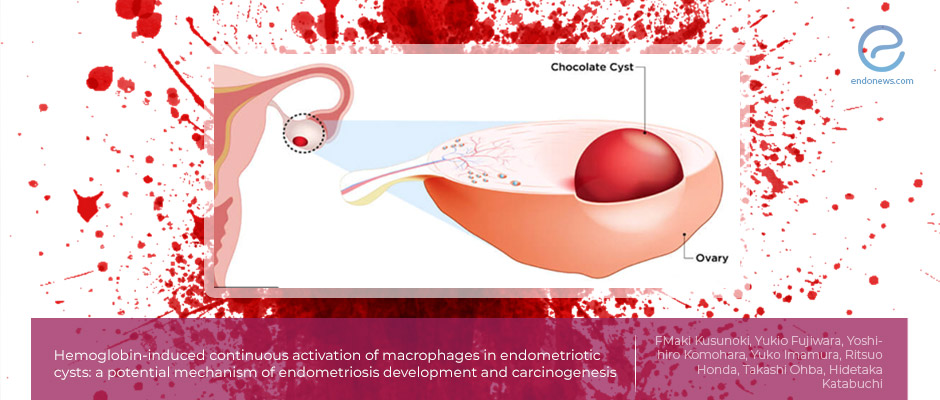Is hemoglobin the immune trigger of endometriosis?
Jan 20, 2021
What is the role of hemoglobin and blood deposits on the production of endometriotic immune response?
Key Points
Highlights:
- Continuous exposure to blood hemoglobin inside the endometriotic foci might trigger endometriosis, and even related cancers by calling macrophages to the site.
Importance:
- The accumulation of blood inside the endometriomas is well known, but the effect of blood and iron on inflammatory cells has not clearly understood yet.
- The study was planned to investigate the effects of hemoglobin on the macrophage-induced inflammatory environment of endometriotic cyst, the distribution of immune cells in the endometriotic cyst wall, and the role of Hb induced macrophage-activation in endometriotic cysts.
What's done here:
- 34 endometrioma cysts walls and 10 cystic fluids were collected from 26 endometriosis patients; fluids were collected from 12 endometriomas of 10 patients.
- Immune cells on the endometriotic cyst walls were examined by immunohistochemistry, using CD68, CD66b, CD3, and CD19 antibodies, to identify macrophages, neutrophils, T- and B-lymphocytes, respectively.
- CD163 (Hb receptor) was also used to analyze the Hb scavenger macrophages, to evaluate Hb metabolism in these cells.
- To assess the ferric iron deposition in the cyst walls, Berlin blue staining was used, and cystic wall samples were grouped according to their percentage of intensity.
- The concentrations of IL-6, TNF-α, IL-10, IL-12, IL-1β, and C–C motif chemokine 2 (CCL2) from cystic fluid were also evaluated.
Key Results:
- Between the immune cells, examined macrophages were the amplest cells in the endometrioma cyst wall.
- The iron was found to be deposited highly where the theCD163-expressing cells were accumulated.
- The concentrations of IL-6, IL-10, IL-1β, and CCL2, and Hb in the cystic fluids were higher than the sera taken from healthy women (especially CCl2 and IL6).
- Both CD163 expression and CCL2, IL6 production in macrophages increased by Hb stimulation in cell cultures of macrophages.
- The production of all cytokines and the levels of CD163 was changed after incubating macrophages with fresh blood but not after the endometrioma fluid content.
Limitations:
- The study explained the results with hemoglobin’s effect on inflammatory cells but did not mention the possible role of iron or reactive oxygen radicals coming with blood instead of hemoglobin itself.
Lay Summary
The role of inflammatory cells in endometriosis has been a popular subject. However, the effects of blood inside the endometriomas were not clarified yet.
The study conducted by Kusunoki et al. and published in the "Medical Molecular Morphology" journal has focused on investigating the effects of hemoglobin on the macrophage-induced inflammatory environment of endometriotic cyst, the distribution of immune cells in the endometriotic cyst wall, and the role of Hb induced macrophage-activation in endometriotic cysts.
The endometrioma cyst walls and the fluid content has been taken. Then the cyst walls were evaluated for the cellular components. The characterization of lymphocytes, mononuclear cells, and neutrophils was done according to their cell surface receptors by immunohistochemistry.
The Hb scavenger macrophages were found to be the most profound inflammatory cell types on the endometrioma walls. Likewise, when the cytokine levels were examined from the endometrioma cyst fluids, statistically high concentrations of CCL2 and IL6 were reached.
Subsequently, macrophage cell cultures were used to understand the effect of old and fresh blood Hb on CD163 positive macrophage cells. CD163 is a high-affinity scavenger receptor for the hemoglobin-haptoglobin complex. It also is a marker of cells from the monocyte/macrophage lineage.
The results revealed a high production of cytokines when the cells exposed to fresh Hb but not old, digested Hb. Based on these results, researchers concluded that Hb metabolism is closely related to the inflammatory environment in endometriotic cysts; monthly renewal of fresh blood inside the endometriomas might be the reason for this production, and by the known effect of IL6 on cancerous conversion, the cancers arising in endometriomas might be explained by this hypothesis.
Research Source: https://pubmed.ncbi.nlm.nih.gov/33392726/
hemoglobin endometrioma inflammatory cells

